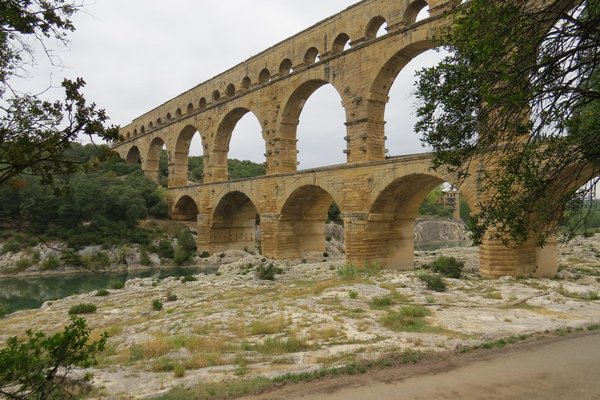France
Pont du Gard
Pont du Gard (Roman Aqueduct) is one of the oldest and most remarkable Roman hydraulic works.
It’s an aqueduct bridge, the major remaining element of a 50km long aqueduct that supplied the Roman colony of Nemausus (Nimes) with water. It spans the river Gardon. The bridge is 48.77m high, has three levels and was built in the 1st century AD.
Community Perspective: It's an impressive structure. Nowadays you have to pay at the ticket booths to even see it from the river banks or the stone footbridge next to it. It is recommended to join a guided tour of the aqueduct channel on the top level of the bridge, which is offered in summer.
Site Info
Official Information
- Full Name
- Pont du Gard (Roman Aqueduct) (ID: 344)
- Country
- France
- Status
-
Inscribed 1985
Site history
History of Pont du Gard
- 1985: Inscribed
- Inscribed
- Type
- Cultural
- Criteria
- i
- iii
- iv
Links
- UNESCO
- whc.unesco.org
- Official
-
- pontdugard.fr — Pont du Gard
- Related
-
- fashionmefrench.blogspot.nl — Getting to Pont du Gard by bus from Avignon or Nimes
- en.wikipedia.org — Wiki on Pont du Gard
All Links
UNESCO.org
- whc.unesco.org — whc.unesco.org/
Official Website
- pontdugard.fr — Pont du Gard
Related Resources
- fashionmefrench.blogspot.nl — Getting to Pont du Gard by bus from Avignon or Nimes
- en.wikipedia.org — Wiki on Pont du Gard
News Article
- Aug. 10, 2015 midilibre.fr — X-rated video filmed under the Pont du Gard
Community Information
- Community Category
- Archaeological site: Ancient Rome
Travel Information
One million visitors or more
Recent Connections
-
Perfect Inscriptions
1985 -
Alexandre Dumas
In his work "Nouvelles impressions de v… -
Depicted in Mizielinska Maps
See i.pinimg.com
Connections of Pont du Gard
- Individual People
-
-
Alexandre Dumas
In his work "Nouvelles impressions de voyage: le Midi de la France", Dumas recounts his visits to Fontainebleau, Lyon, Orange and its Roman vestiges, Avignon, the Pont du Gard and Arles.
-
- Geography
- Trivia
-
-
Depicted in Mizielinska Maps
See i.pinimg.com
-
One million visitors or more
Visited by almost 1,000,000 French and foreign visitors every year (official website 2025) -
Cercle events
NolahSee www.youtube.com
-
- History
-
-
Ancient Roman colonies
Was built to meet the needs of the colony Nemausu
-
- World Heritage Process
-
-
Single Monuments
Also meets criterion i: masterpiece of human creative genius. -
Perfect Inscriptions
1985
-
- Human Activity
-
-
Erotic art
A Phallus (though others think it's a hare): “It actually evokes Priapus and responds to a prophylactic function (preventing evils or protecting oneself against them) or apotropaic (diverting malefic influences towards another object). It is supposed to protect the structure from floods and evil spells. It is also a lucky charm placed in houses, on paths, in fields, gardens, on public monuments and in places where danger is potential. It is also a symbol of the fertility, the population and the splendor of the colony of Nîmes.” -
Grand Tour
From the 18th century onwards, particularly after the construction of the new road bridge, it became a famous staging-post for travellers on the Grand Tour (wiki) -
Historical Graffiti
19th century graffiti (f.e. some Jean in 1830) is scratched into the main aquaduct at the level of the footbridge
-
- Constructions
-
-
Notable Bridges
It's both an Aquaduct and a Bridge ("After the collapse of the Roman Empire and the aqueduct's fall into disuse, the Pont du Gard remained largely intact due to the importance of its secondary function as a toll bridge." - wiki) -
Purpose Built Visitor Centre
2000, Buffer zone ("On each bank of the Gardon River a welcoming and information centre has been built, placed 500m from the Pont du Gard in order to be out of sight when walking on the monument")See www.viguier.com
-
Aqueduct
-
- WHS on Other Lists
-
-
World Biosphere Reserves
Gorges du Gardon biosphere reserve (2015)
-
- Timeline
-
-
Built in the 1st century
built in the first half of the first Century
-
- WHS Hotspots
News
- midilibre.fr 08/10/2015
- X-rated video filmed under the Pon…
Recent Visitors
Visitors of Pont du Gard
- Adam Hancock
- Adrian Turtschi
- Aitia
- Albert
- Alberto Rodriguez Gutierrez
- Alexander Barabanov
- Alexander Lehmann
- Alexander Parsons
- Alex Baranda
- AlexSchedel
- alicemears
- ALS
- A. Mehmet Haksever
- Ammon Watkins
- Ana Lozano
- Angela Vandyck
- Argo
- arnaugir
- Artur Anuszewski
- Aspasia
- Assif
- Astraftis
- a.thum
- Atila Ege
- Aunti
- AustralLights
- Bamse
- Bauchat
- BaziFettehenne
- Bill Maurmann
- Bin
- Birgitte Sørensen
- Bodil Ankerly
- bossc
- Brendan Carroll
- Bropyk
- CampbellME
- campmany
- Carlos Sotelo
- Caspar
- chenboada
- Cheryl
- Chole Ross
- ChrisN
- Christian Wagner
- Christine
- Christoph
- Christravelblog
- Chunsian01
- Claire Bradshaw
- Clyde
- Cobaltrage
- Col
- Colossus
- Corinne Vail
- Cristina Erba
- Csaba Nováczky
- ctravel
- CugelVance
- Cyberczar
- CynthiaW
- Dagmara
- Damientournay
- Dani Cyr
- Daniela Hohmann
- Daniel Chazad
- Daniel Gabi
- Daniel R-F
- Danny L
- Dan Pettigrew
- David Aaronson
- David Berlanda
- DavidS
- Dimitar Krastev
- Dimitrios Polychronopoulos
- DL
- Doubanjiang
- DutchHorn
- Dwight Zehuan Xiao
- Echwel
- Elaine McArdle
- Els Slots
- erdsaumnaht
- Erfe91
- Erik Jelinek
- Ertai
- Eva Kisgyorgy
- Evgenii
- fabi-ddorf
- Fan Yibo
- Farinelli
- Feldhase
- Felicité
- Femke Roos
- Fernweh
- Filip Murlak
- Filippo Ubaldi
- finsbury_jo
- Flexiear
- Francky D'Hoop
- FrankW
- Frederik Dawson
- FS
- Galgalula
- Gary Arndt
- g.emma_bae
- George Gdanski
- GeorgeIng61
- GerhardM
- Gernot
- Gilles
- giloudepuertorico
- Gjert
- Grzegorz Andruszkiewicz
- Hadrianus
- HaraldOest
- Harald T.
- Harry Mitsidis
- Hasco
- H Beswick
- Hdhuntphotography
- Highlander
- Hubert
- Hughes1920
- Iain Jackson
- Ian Cade
- Ilya Burlak
- Ingemar Eriksson
- IreneKD
- Ivan
- Ivan Rucek
- Jaakkotoivanen
- Jacob Otten
- Jakob F.
- Jana and Matt
- Janina Lehmann
- Jan-Willem
- Jan Zimmermann
- Jarek Pokrzywnicki
- Jarrod_Byham
- Jasam
- Javier Coro
- Jean Lecaillon
- Jeanne OGrady
- Jeffrey Chai
- Jens
- Jezza
- Joel on the Road
- Jonas Kremer
- jonathanfr
- Jonoprout
- JoStof
- Joyce van Soest
- JR's HERITAGE SITES
- KarenBMoore
- Karito Vies
- kayakka
- Kbecq
- Kbooth
- Ken DJ
- Kerékgyártó
- Klaus Freisinger
- Knut
- KoenigMarke
- krtek
- Krzysztof B
- kutasp
- Laetitia Yin
- Lara Adler
- Laurine
- Liamps91
- Lindaflat
- Lithobates
- ljowers
- Loic Pedras
- Luboang
- Lucas Del Puppo
- Lucio
- Ludvan
- Luis Filipe Gaspar
- lynnz317@aol.com
- Maciej Gil
- Mahuhe
- Malgorzata Kopczynska
- Małgosia Łupicka
- Manuelfunk
- marcel staron
- Marcobrey
- marc Rouserez
- Marinemajor
- Martin
- Martina Rúčková
- Matejicek
- Mathijs
- Matthewsharris
- MAURO PODDA PANI
- Max
- MaxHeAnouBen
- MaYumin
- MH
- Michael Novins
- michaelsballard
- Michael Turtle
- Mikko
- Mikko Syrjä
- Milan Jirasek
- Mohboh
- Monica Tasciotti
- MoPython
- Morodhi
- Mstrebl1990
- Naim Y
- nan
- Nasebaer
- Niall Sclater
- Nicolas
- Nihal Ege
- nikolasruffet
- NoahFranc
- opperpco3
- PabloNorte
- Pat Martin
- Patrik
- Paul Schofield
- Peltzi
- PeterA
- PeterH
- Peter Lööv
- Petteri
- Philipp Leu
- Philipp Peterer
- phillipmeng
- Pink Bunny
- Piotr Wasil
- Potsdamer
- Purrfect
- Rahelka
- Ralf Regele
- Randi Thomsen
- reddargon
- Reiseblitz
- Reisedachs
- Rick Ohm
- RobRos
- Roger Enarsson
- Roger Ourset
- Roman Bruehwiler
- Roman Raab
- Ronbon
- Sabrina Liebehentschel
- Sandmann15
- Sclowitz
- scubarrie
- Sergio Arjona
- Shandos Cleaver
- Shijie ZHU
- sibariam
- sime147
- Simonf
- Simonh
- SirLoydd
- Solivagant
- Sorel Americo
- Squiffy
- Stanislaw Warwas
- Stefan A. Michelfeit
- Stefan Loov
- stephhollett
- Stijn
- Svein Elias
- Szabolcs Mosonyi
- Szucs Tamas
- Tammy Gouldstone
- Taotao Chen
- Tarquinio_Superbo
- Tcchang0825
- Ted Coombs
- Tevity
- Thomas Buechler
- Thomas Harold Watson
- Thomas van der Walt
- Thorben
- Tim Allen
- Tinuszke
- Tom Flaten
- Tonisan
- tony0001
- triath
- Truls Brekke
- Tschibi
- Tsunami
- ValiaVeweth
- Vanessa Buechler
- Van Hung
- Velvetlapis
- Veronica
- vhorne
- Viaje al Patrimonio
- Vincent Cheung
- V&M
- voyager
- WalGra
- Walter
- Westwards
- WILLIAM RICH
- Wimmy
- Wojciech Fedoruk
- Wo_ko
- Xiquinho Silva
- Zach
- Zhenjun Liu
- Zoë Sheng
Community Reviews
Show full reviews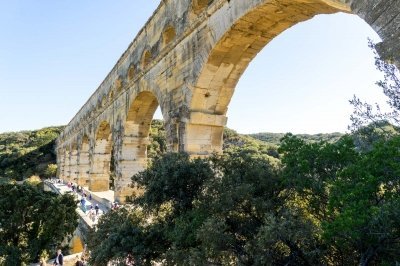
Although the Pont du Gard is not near to any main towns, it is definitely worth the effort to go and visit. It's quite an awe-inspiring site to see the scale of the bridge in person and I did a lot of walking around to get views of the structure from different perspectives.
The admission cost is quite reasonable and I would highly recommend getting the ticket that gives you access to the museum and takes you on a guided tour of the aqueduct channel on the top level of the bridge. The museum has excellent exhibitions that explain the history of the site, and I don't think you can really appreciate how it works until you walk along the top level.
The management of the site has done an excellent job of preserving the site, offering an authentic historical experience, but also creating an enjoyable visitor environment. I love that you can have a picnic on the sand or go for a swim in the river on the a summer's day, if you want.
Keep reading 0 comments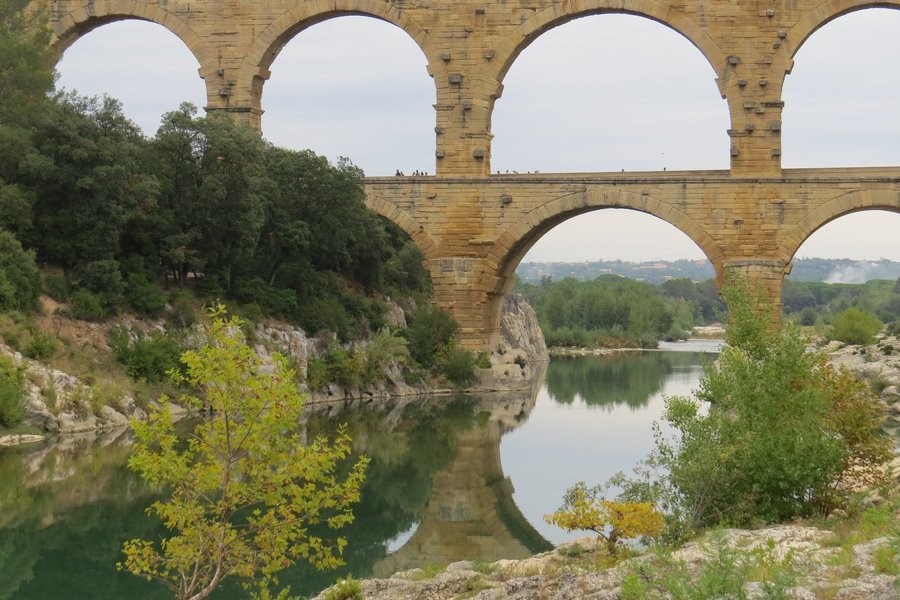
The Pont du Gard is one of the iconic masterpieces of Roman architecture and engineering, and one of France’s most famous and recognizable landmarks. It is the highest of all Roman aqueducts and one of the best preserved (similar to its equally famous counterpart in Segovia). Apparently, it took just 5 years to build and was in use for a good five centuries to provide Nimes (Nemausus) with fresh mountain water. The bridge next to the arches was only built in the 18th century. There are 3 tiers of arches, and in summer, there are guided tours (for a supplement) on the top tier (labelled “canalisation”), which was really quite interesting. It can be easily reached by bus from Nimes and Avignon (the stop is on the roundabout on the main road, from there it’s just a 5-minute walk to the ticket counter). On a hot summer day, however, most visitors seem to come less for the monument itself than for the leisure opportunities (swimming, canoeing, sunbathing, hiking). Even if your visit is for historical reasons, you can always dip your toes in the cool river water. One of the best ancient sites anywhere.
Keep reading 0 comments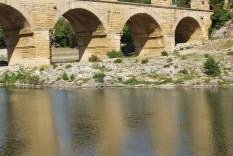
Pont du Gard is one of the most iconic remains of the Roman period, and I was glad as I finally could tick off this WHS in June 2013. Actually it was my second visit, but I have only sparse memories of a stopover on the way to Spain with my parents when I was a child. At that time access was free and it was possible to walk along the water conduit at the upper level.
Pont du Gard is really impressive, by its height and by its state of preservation. When we stood on the banks of the Gardon, we looked up at the top tier and tried to see the skew of the bridge. But it is not visible, the bridge descends by only 2.5 cm. But you can easily see that the span of the arches varies. And: it's not the bridge on the 5 Euro note. The drawings on the Euro banknotes depict archetypes, not real buildings. Take a 5 Euro note and compare, you will easily notice the major difference: in the real bridge, the piers of the lower and the middle tiers are in line one above another; probably to reduce the load on the arches and to enhance stability. From a shorter distance, you see the protruding stone blocks that were used to fix the scaffolding.
This is certainly a WHS where the weather crucially contributes to the pleasure of the visit. Our visit was on a wonderful sunny day. We climbed …
Keep reading 0 comments
We visited long ago in 1988. At that time it was totally devoid of attendants or parking charges. We were free to roam ,cross and climb where we wished, in fact my wife and daughter crossed via the water course tunnel and myself and Andy (our daughter's friend) actually crossed on the very top.It was quite disconcerting to have to pass by people coming the other way,(with 2 kids and a dog!) when there was no protection whatsoever. I have some photos taken of the experience if you would like to see them.
Keep reading 0 comments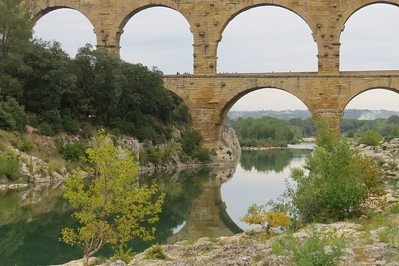
Even when you arrive on foot, the entrance to this site is not free anymore. The walking path from the bus stop to the visitor center conveniently passes the ticket booths that are set up to sell drive-by tickets for cars. There may be ways around paying it (especially when it is a busy day in summer), but that would not be easy for a first-time visitor. My 10 EUR ticket wasn’t checked anywhere further on the premises, not even at the “museum”.
The visitor center has been a relatively recent addition to the site and is said to have improved the visiting experience. Fortunately, I went there on a quiet autumn day, but the center clearly was built for receiving masses. The toilets and a relatively cheap & cheerful self-service cafeteria were OK though. I only visited the museum exhibition on my way out – there aren’t any unmissable pieces to see, but I came to know some worthwhile facts from the displays and multimedia presentations. Such as how the aqueduct fell into decay relatively quickly. It has been used for about 150 years, but the water quality deteriorated fast after the initial streams of water passed. It wasn’t good enough anymore to fill the city’s baths and was only used in agriculture. The exhibition also states that the Roman aqueducts around Europe were built as “stone flags” – marking the territory mostly.
The aqueduct / bridge itself lies somewhat hidden in the landscape, and you’ll only …
Keep reading 0 comments
Purposely hidden from the road, this magnificent sight fills you with awe and wonder. It is so spectacular. Take a picnic and spend the whole day under the aqueduct, simply admiring its magnificence or paddling in the water, which is quite shallow at this point. Boats can be hired too. Not a cheap place to visit but sights that blow you away. Has something to offer all of the family.
Keep reading 0 comments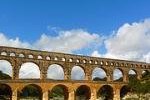
I visited this WHS in May 2012. It is surely one of the top WHS France has to offer IMO. The Visitor Centre is not that informative and it felt as if it was simply built to rake in an entrance fee from so many people who visit this site. The light shows organised there are quite interesting but the nature surrounding this huge WHS (olive groves, garigue land, the sound of the stream of water, etc) make it one of my personal favourite WHS. Bdw ... it is the same aqueduct depicted on the 5 Euro note :)
Keep reading 0 comments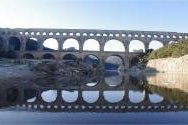
The roman bridge of Pont du Gard is a real marvel. Crossing the Gard River, the bridge has been well renovated to allow visitors to enjoy the place in the best possible way. A museum have been set up at the entrance of the site and offers greats explanations and testimonies of the Roman life and mainly, the building of the bridge and its techniques. It is possible to walk on the first level of this three-level bridge. Almost 50 meters high and 275 meters long, the bridge was part of the 50 km aqueduct carrying water from Uzès to Nimes during the Roman period.
Keep reading 0 comments
We visited this site in July 2008 from Avignon and the bus schedules has vastly changed. There are now over half a dozen buses a day leaving for the Pont du Gard so it is much more convenient for tourists. We took the 10:45 one there and took the 1:15 one back to Avignon, spending almost 2 hours (more than enough time for us) to view the site. It was worth the effort and best of all, it is free to enter.
Keep reading 0 comments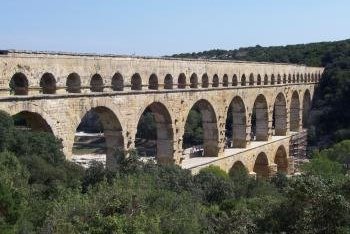
It is quite impressive to see infrastructure on the World Heritage list, and this site is very deserving of its place on the list. The structure is absolutely massive and an astounding feat of engineering. It is 50 metres high and is part of the aqueduct that ran to Nimes over a distance of 50km. If you look closely you can see that the arches are not actually the same size but vary slightly.
The top tier has the aqueduct running along it. It is possible to have a guided tour of this. I did climb up the banks with the hope of seeing inside, but unfortunately you can only see a locked door and a staircase. It was worth the climb though, as the view was very impressive (picture).
You can walk across the bridge for free; well you actually walk on the 18th century one built next to the roman structure at the first level which mirrors it so you can’t see the difference from a distance. There are great views from the picnic area on the left bank and plenty of trails off around the area if you fancied a hike or cycle. If you want to go for a swim take an old pair of shoes as the water is very rocky and very cold; we found this out the hard way.
On practical matters, there is a brand new interpretive centre on the right bank. Busses will drop you off near here. There are 3 …
Keep reading 0 comments
In our trip to France we have seen the Roman Pont du Gard, a part of the aqueduct that brought water by a 50 km long canal to the castellum divisorium of Nîmes, in the Narbonnaise region, from a spring near Uzès. To achieve an average of 34 cm par one km it follows sinuous pats or traverses the rock layer with galleries or is elevated on to walls or arches or bridges. The Pont du Gard goes over the deep valley of the river Gardon; it was constructed in 19 for order of Agrippa. It’s 49 m high and has three storeys: the first (142 m long) has six 22 m high arches and was used in Medieval times like a bridge, the second 8142 m long) eleven 20 m high arches and the last (275 m long), where runs the canal, thirty-five 7 m high arches. There was also adaptations of the devastating course of the river and the lips on the piers, the curved layout of the aqueduct and the opening of the main lower arch are designed to resist to the floods. The acqueduct use at the two lower levels stone blocks, that can weight up to six tons, and at the upper levels small stone rubble which hold the abuting flagstones of the canal.
The acqueduct is one of the most beautiful places I have ever seen because of its impresivenesse and its incredible technique of consctruction; it's absolutely worth to be visit - you …
Keep reading 0 comments
Each time we have visited the Pont du Gard (Bridge over the Gard River), ten or twelve miles northeast of Nîmes, the weather has been sparkling clear, but rain or shine, it’s an awe-inspiring structure. The aqueduct was built without mortar between the stones (some weighted six tons), and we know engineering codes wouldn’t permit that these days. Of course it’s most likely that structures built under our engineering codes won’t last 2,000 years, either.
The first times we were here we were able to drive across the bridge with no problem, but on our fourth visit, police had blocked access to the road. The next morning, the police were gone, and we again drove across the Pont du Gard. Why is that so exciting, since we’ve done it a couple of times? Well, who else do you know who has done it even once?
From our book, Invitation To France (Google)
Keep reading 0 comments
